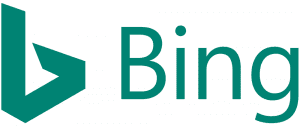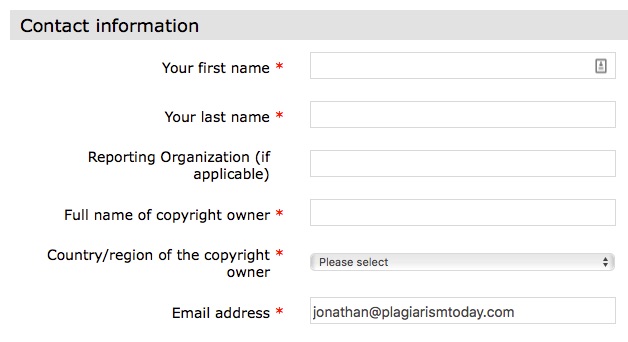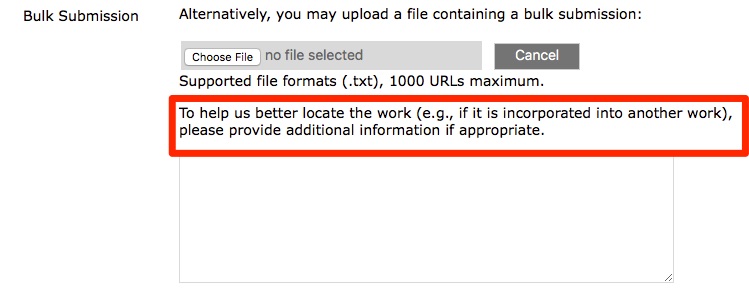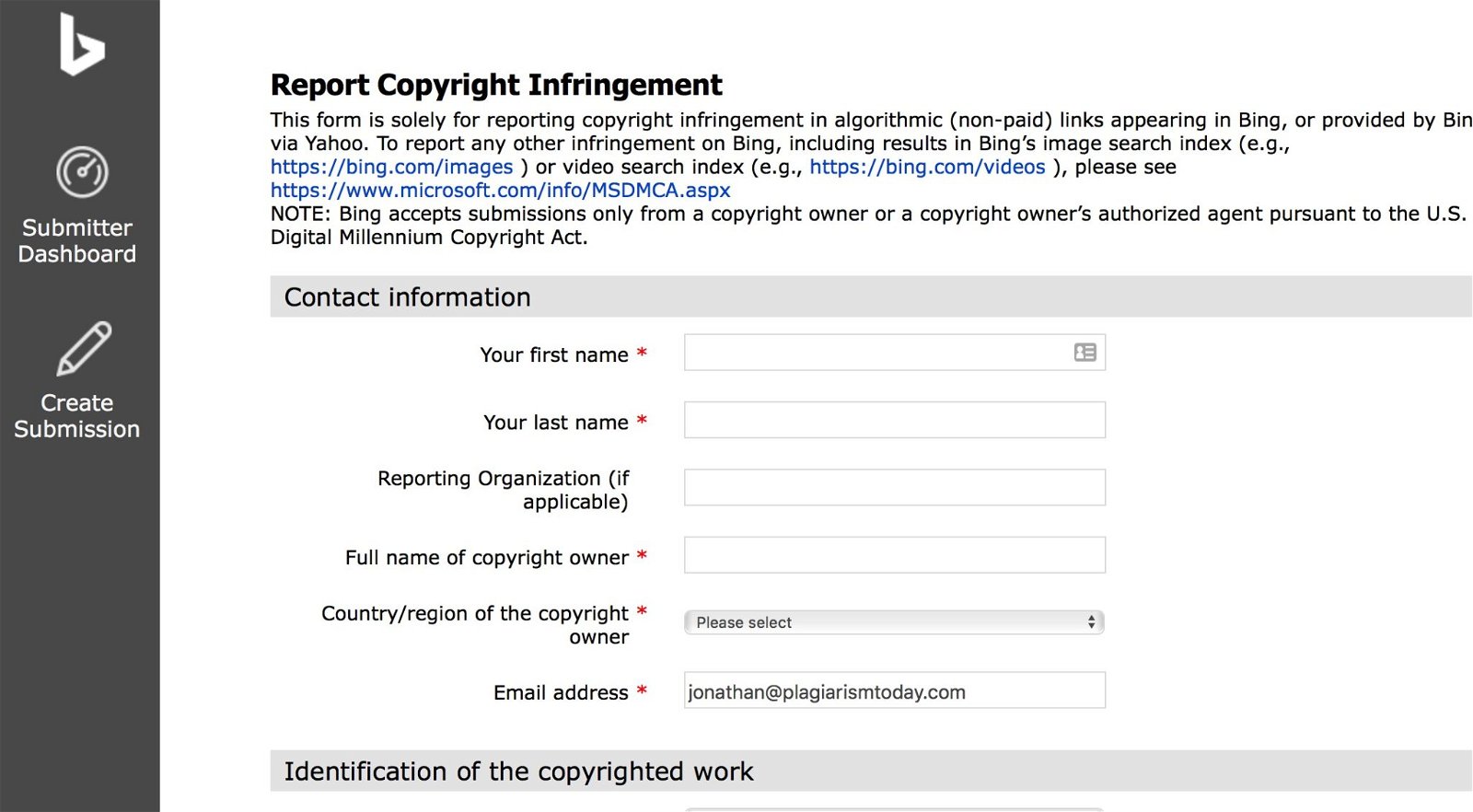Why Bing’s DMCA Form is Better Than Google’s
When a little design work goes a long, long way.
 When it comes to search engines, there isn’t much doubt that Bing is not as popular as Google.
When it comes to search engines, there isn’t much doubt that Bing is not as popular as Google.
Though Bing has enjoyed some niche success, especially with image search, it has not enjoyed Google’s mass appeal.
Nowhere is this more evident than Digital Millennium Copyright Act (DMCA) notices (notices to remove content on copyright grounds).
According to Microsoft’s transparency report, between July and December of 2016 they received some 4.1 million copyright-related removal requests. While that’s a large number, Google, according to their transparency report, received the 20 million requests in just the first week of that period.
But just because Bing isn’t as big of a target for DMCA notices doesn’t mean it can’t be a source of innovation in this area. A recent announcement that Bing had updated its copyright reporting tools made this a great opportunity to take a fresh look at Bing’s copyright process and see if there are lessons that other search engines and hosts could learn from it.
It should suffice to say, there is a great deal that Bing does better than Google in this area, especially when one looks at their forms.
A Form of Beauty
To be clear, finding Bing’s copyright notice form is not a simple task.
Most efforts will first take you to Microsoft’s page for filing notices of infringements. That page lists all of the different services Microsoft provides but does put Bing in a category all of its own.
Once you click the Bing logo, you next have to be careful not to click the form related to paid advertisements. Though the text makes it clear which form is which, for reasons not clear to me, it’s the first link on the page.
From there though, you’re taken to Bing’s form for reporting copyright infringement and, to be frank, it’s a beautiful form.
From a design standpoint, it’s very clear and easy to understand. Someone who is filing their first-ever copyright notice would have almost as easy of a time following the process as someone on their millionth.
The form doesn’t ask for unnecessary information, but remains flexible enough for just about any situation. This includes if you’re filing as an agent, needing to do bulk filing (up to 1,000 URLs) or even need to provide an attachment of the original work.
Most importantly, it’s well laid out and shows actual thought for the filer, not just the people who have to receive the notice.
While these might not seem like major innovations, they are pretty significant when you compare them to Google.
Comparing Bing’s DMCA form to Google’s
Much of the benefit to Bing’s form over Google’s is not functionality or content, but rather, design. Where Google’s form looks like it was built as quickly as possible, Bing’s shows an intent to make the form easy to use and parse.
For example, take a look at the differences in the “Contact Information” section on both forms. First, here’s Google’s.

Now here’s Bing’s.

The difference is striking. Bing’s form has better typography, clearly defined sections, better layout and doesn’t ask for unneeded information (No country dropdown and it’s easier to identify yourself as an agent).
These are small differences, but they can be very big for someone who is new to the process.
One feature that Bing does add is an optional box to provide any additional information about the infringement.

This actually addresses one of the recurring challenges I’ve had with Google, where I file a notice with clear text plagiarism only to have it rejected because whoever processed the notice couldn’t see the infringement. This is usually fixed just by me emailing back a text-highlighted version of the page, which Google does not make it simple to provide when the initial notice is filed.
This not only means the infringing work is up longer, but creates more work for everyone involved.
Finally, where both parties do a similar process of having users click to agree to the three required sworn statements, Bing provides extra help by making it clear what each statement is in addition to providing the text.
Once again, here’s Google’s.

And here’s Bing’s.

In addition to better design (including text wrapping), the Bing version has a clear title for each statement, making it quick for someone who is familiar with the law to understand what each statement is.
The only real downside to Bing’s DMCA form is that you need to file a separate notice for each original work. While you can file 1,000 URLs for a single infringed work, two URLs for two different infringed works requires two notices.
With Google, you can do up to 10 “Groups”, each group representing one original work. Bing could easily remedy this, but doesn’t right now.
What Can Google (And Others) Learn
 From a DMCA filer’s perspective, forms are fairly annoying. They take longer to fill out, they don’t provide the same paper trail as email and they often bring technical issues with them.
From a DMCA filer’s perspective, forms are fairly annoying. They take longer to fill out, they don’t provide the same paper trail as email and they often bring technical issues with them.
For most filers, it’s just faster and more reliable to send emails, which can be templated, and not bother with forms.
However, for hosts the benefits are obvious. Forms help streamline the processing of notices on the backend, prevent incomplete notices from being sent and, in some cases, ensure that the host is the correct one.
These benefits, however, are lost if people either don’t use the form or aren’t able to provide all of the information needed.
Form’s like Google’s were designed exclusively with the host’s needs in mind. They show zero thought into how the make the form more usable for users. The same company that tested 41 different shades of blue for links in its search engine, took no time to make its DMCA form user friendly.
Though most large-scale copyright holders use a special backend for providing DMCA notices, one that bypasses their form, those who use this form still need it.
In short, if you’re a host or a search engine that feels creating a form for DMCA claims is worthwhile, it’s also worth taking the little bit of extra time needed to design the form properly and make sure it’s easily used by the people who need it.
Because if the form provides bad information or gets passed over for email constantly, it does no good.
In short, a little bit of design work can go a very long way.
Bottom Line
In the end, what this speaks to is thought and care. Bing probably didn’t spend a great deal of time designing its form. It’s a fairly basic form with a simple layout that’s widely used elsewhere on the web, including on Bing itself.
But that little bit of extra thought makes the form so much easier to read, to use and to work with. That makes it easier to file correct and complete notices, makes it easer for filers to give the information that will allow Bing’s people to correctly and quickly process the claims.
I’m not saying anything (at this point) about how well Bing and Google respond to notices when compared to one another, how they approach the backend is a different question. However, their relative efforts on their frontends show a great deal about how the two companies approach copyright issues and that says nothing good about Google.
In short, if you’re a host or a search engine and you’re going to have a DMCA form, take the time to do it right. Make sure it’s usable, readable, has solid design and is tested.
Too many hosts fail those simple tasks and their DMCA process suffers because of it.
Want to Reuse or Republish this Content?
If you want to feature this article in your site, classroom or elsewhere, just let us know! We usually grant permission within 24 hours.
